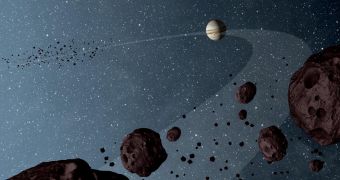NASA's Wide-field Infrared Survey Explorer (WISE) has given scientists more data about the Jovian Trojans, the packs of asteroids that orbit the sun following Jupiter's orbit.
These asteroids are quite mysterious and scientists are trying to figure out how they formed and why are they following the orbit they have.
These peculiar asteroids come in two large packs, one leading Jupiter, the other trailing. These asteroids were first discovered more than a century ago, but until recently it was unclear how many they were or what they were made of.
NASA's WISE has been a huge source of information on these objects. The space telescope has found that the asteroids are dark, reddish in color and have matte surfaces.
Very little visible light is reflected, which is why the infrared telescope is much better at spotting them than regular telescopes.
The study also found that there were considerably more asteroids in the leading pack, 40 percent more, than in the trailing pack.
Overall, it is believed that there are more asteroids there than in the entire asteroid belt between Mars and Jupiter.
What's more, the asteroids following Jupiter are unlike those in either the asteroid belt or the Kuiper belt, indicating that they formed in place or at the very least that they have one common and original source.
There were no "outsiders" either, from other parts of the Solar System, all of the asteroids studied were similar in nature.
"Jupiter and Saturn are in calm, stable orbits today, but in their past, they rumbled around and disrupted any asteroids that were in orbit with these planets," Tommy Grav, a WISE scientist said.
"Later, Jupiter re-captured the Trojan asteroids, but we don't know where they came from. Our results suggest they may have been captured locally. If so, that's exciting because it means these asteroids could be made of primordial material from this particular part of the solar system, something we don't know much about," he added.
There is still plenty of data from the WISE telescope to be analyzed. The Jupiter Trojans are unique in the Solar Systems, several planets were found to have similar companions Mars, Neptune and even Earth. In fact, the first Earth Trojan was discovered by WISE recently.

 14 DAY TRIAL //
14 DAY TRIAL //